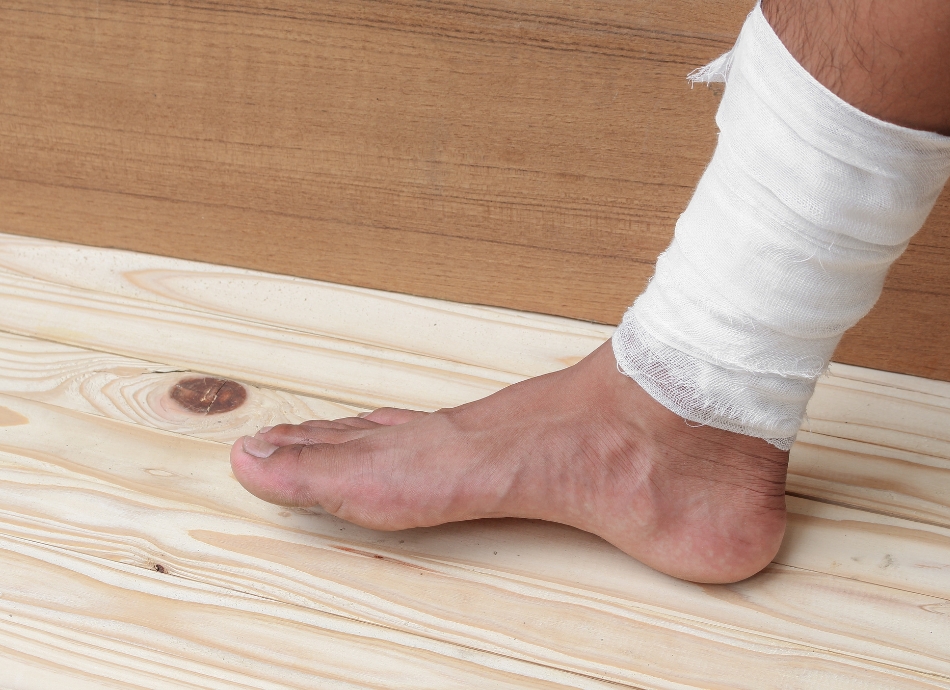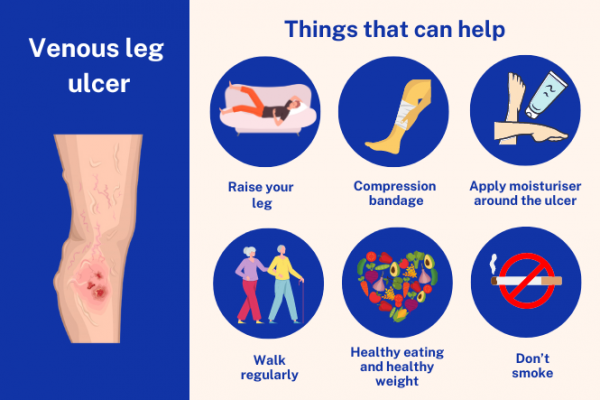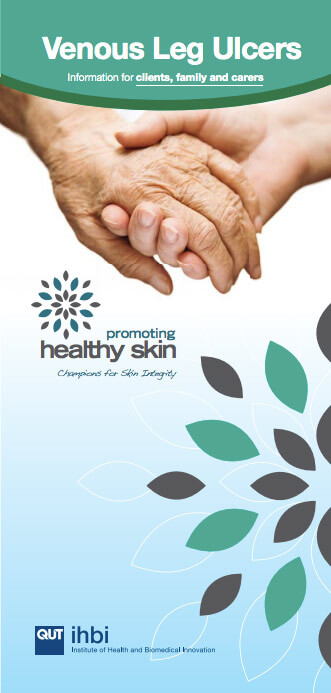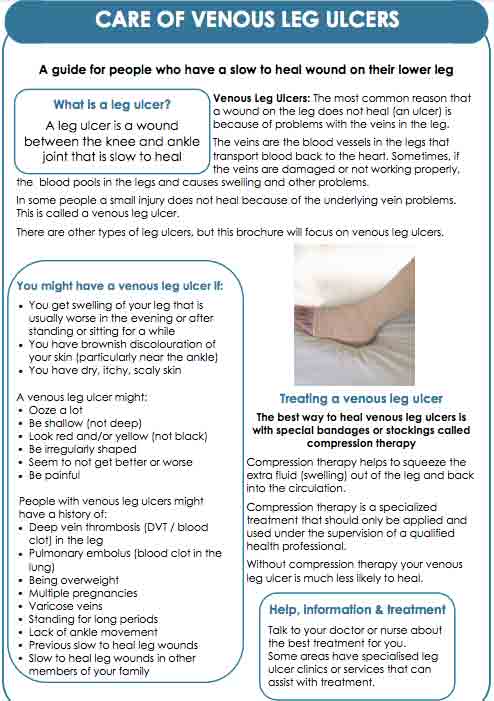Venous leg ulcers
Wounds on your leg that heal slowly due to poor circulation
Key points about venous leg ulcers
- A venous leg ulcer is a wound on your leg (between your knee and ankle) that takes a long time to heal due to poor blood circulation.
- Often an ulcer will develop after a minor injury to your leg when the wound doesn't heal.
- It can be be painful and itchy and cause swelling of your leg.
- A venous leg ulcer usually won’t get better without specialised treatment.
- Risk factors include being older, overweight, having a history of varicose veins or deep vein thrombosis (DVT), and having trouble moving around.

A venous leg ulcer is a wound on your leg that takes a long time to heal because of poor blood circulation. It's also known as a venous stasis ulcer or a non-healing wound.
It usually develops on the inside of your lower leg, above your ankle. It will often develop after you've had a minor injury to your leg, and can be painful and itchy and cause swelling in your leg.
A venous leg ulcer won't usually get better without treatment which commonly involves specialised wound care and compression therapy. See the treatment section below.

Image credit: Healthify He Puna Waiora
The most common symptom of a venous leg ulcer is a wound that doesn’t heal and is irregularly shaped with dry, hard skin around the outside. It develops on the skin below your knee, usually on the inside of your lower leg above your ankle
Other symptoms include:
- swelling, especially around the ankle of your affected leg
- aching legs
- pain
- clear discharge
- red-brown colouring on the affected skin.
Venous leg ulcers can easily become infected because they’re slow to heal. Signs of an infected leg ulcer include:
- increased pain
- green, smelly discharge (pus)
- developing a fever (high temperature)
- increased swelling and redness around the wound.
Contact your healthcare provider if you develop any of these symptoms.
Venous leg ulcers develop because of problems with the blood circulation in your leg veins. Valves in your legs help to push blood from your legs and feet back up towards your heart. If these valves become damaged, the blood pools in your leg veins, causing pressure and skin changes.
Often an ulcer will develop after a minor injury to your leg. If you have poor circulation the wound doesn't heal.
Risk factors
Your risk of developing a venous leg ulcer is greater if you:
- have a history of varicose veins (mate ia auraki)
- have limited mobility
- have a history of deep vein thrombosis (DVT, poketoto)
- have had a venous leg ulcer before
- have had a lower leg fracture or injury
- have had surgery on your lower leg
- are over 60 years of age
- are overweight
- have had multiple pregnancies
- have to stand for long periods of time.
A venous leg ulcer is usually diagnosed based on what it looks like, how long it's been there, your health history and other risk factors. Your healthcare provider may organise other tests to see if you also have peripheral vascular disease or check your circulation before starting treatment.
A venous leg ulcer won't usually get better without treatment from a health professional. The aim of treatment is to make sure the wound heals while providing relief from symptoms (eg, pain and swelling).
Your healthcare provider may recommend specialist wound care and compression therapy to help with healing. Treatment will usually be done by a district nurse who is specifically trained to manage leg ulcers.
- Wound care involves debridement (removing dead tissue) and treating venous eczema with topical steroids and emollients (moisturisers). Venous eczema is a type of eczema that can occur when you have venous insufficiency (poor blood flow from your legs back up to your heart).
- Compression therapy applies pressure to your affected leg by using layers of elastic bandaging. This reduces the amount of blood that can pool in your veins and helps to redirect blood flow to your heart. It can help reduce swelling and improves the supply of oxygen and nutrients to the wound which helps the healing process.
Medicines
Paracetamol can help with relieving pain. If your ulcer is infected your healthcare provider may prescribe an antibiotic by mouth.
Other treatments
Your healthcare provider may consider referring you to a vascular surgeon to discuss a minimally invasive procedure for varicose veins. This will reduce the risk of ulcers coming back repeatedly.
Other treatments may be tried if your ulcer doesn't improve. One possible treatment is hyperbaric oxygen therapy where you breathe in pure oxygen in a special pressurised environment. This is only available in Auckland or Christchurch if your ulcers meet specific criteria.
Infection
Infection is the most common complication, venous leg ulcers are at risk of becoming infected because they're slow to heal. Systemic (oral) antibiotics are used if there are signs of infection. Topical antibiotics (antibiotic ointments) aren't recommended because they can slow the healing process down.
Signs that a venous leg ulcer may need treatment with antibiotics include:
- increasing swelling, redness and warmth around the wound
- increasing pain
- the wound getting larger
- more green and smelly discharge (pus) from the wound
- a fever (high temperature).
Other complications can include:
- infection of the bone
- permanent scarring
- skin cancer (this is rare).
Once treatment has started, venous leg ulcers can still take a few months to heal. You’re more at risk of developing another one if you don’t treat the underlying cause of the ulcer. Although some venous ulcers can't be avoided, there are a few things you can do to minimise your chance of developing one. These steps will also help the healing process if you're having treatment for an existing leg ulcer.
- Exercise regularly – walk as much as possible using a heel-toe action.
- Eat a healthy diet
- Don't smoke.
- Avoid sitting or standing for long periods
- Maintain a healthy weight.
- Raise your feet as close to hip height as you can during the day to help with the return of blood flow to your heart. If you have an ulcer, raise the affected leg – try to keep your foot higher than your heart and aim to do this for 30 minutes at least once a day. A good way to do it is to lie on a couch and put your leg up on the arm of the couch. You can use a cushion to lift it higher. You can also sit and put your leg up on a footstool, or lie on the floor and put your leg up on a cushion.
Good skin care is also important if you have a venous leg ulcer. You may need to get help if you can't remove your compression bandages yourself.
- Gently wash your legs with a non-soap cleanser, drinking water from the tap is fine to use.
- Moisturise your legs and feet regularly but avoid open wounds and the skin between your toes.
Apps reviewed by Healthify
You may find it useful to look at some Self-management and healthy living apps, Nutrition, exercise and weight management apps, and Pain management apps.
Venous leg ulcers are chronic (long-term) and can last for months or even years. Getting more is common unless the cause of your ulcer is effectively treated. You should aim to reduce any risk factors for venous leg ulcers to improve healing and reduce the chance or a recurrence (getting another ulcer).
After your ulcer has healed you should wear compression stockings that have been specially fitted for you to help reduce the risk of another ulcer developing.
Venous ulcer(external link) DermNet NZ
Chronic venous insufficiency and leg ulcers(external link) Australian and New Zealand Society for Vascular Surgery
Venous leg ulcers(external link) Institute of Health and Biomedical Innovation, Australia
Good food for wound healing(external link) HealthInfo, NZ
Helping my wound health(external link) HealthInfo, NZ
Apps
Self-management and healthy living apps
Nutrition, exercise and weight management apps
Pain management apps
Brochures
What is a venous leg ulcer?(external link) New Zealand Wound Care Society
Treating venous leg ulcers and maintaining leg health(external link) New Zealand Wound Care Society
Preventing venous leg ulcers(external link) New Zealand Wound Care Society
Care of venous leg ulcers(external link) Wounds Australia
Factsheet 11 – what is a venous leg ulcer?(external link) Wounds Australia
References
- Australia and NZ Clinical Practice Guideline for Prevention and Management of Venous Leg Ulcers(external link) NZ Wound Care Society, 2011
- Treating venous leg ulcers(external link) NZ Wound Care Society, 2013
- Stasis ulcer(external link) DermNet, NZ, 2016
- Overview – venous leg ulcer(external link) NHS, UK, 2022
- Factsheet 11 – what is a venous leg ulcer?(external link) Wounds Australia
- Chronic venous insufficiency and leg ulcers(external link) Australian and New Zealand Society for Vascular Surgery
- Leg ulcers(external link) Auckland Region HealthPathways, NZ, 2020
- Stasis dermatitis and ulcers(external link) Medline Plus, US, 2022
Australia and NZ clinical practice guideline for prevention and management of venous leg ulcers(external link) NZ Wound Care Society, 2011
Microbiological assessment of infected wounds – when to take a swab and how to interpret the results(external link) BPAC, NZ, 2013
Flow chart for management of venous leg ulcers(external link) Australian and NZ, NZWCS
Venous ulcer clinical pathway(external link) Australian and NZ, NZWCS
Hyperbaric Medicine Unit referral information for Auckland(external link) and Christchurch(external link)
Apps
Self-management and healthy living apps
Nutrition, exercise and weight management apps
Pain management apps
Brochures

Institute of Health and Biomedical Innovation, Australia

Treating venous leg ulcers and maintaining leg health
New Zealand Wound Care Society, NZ, 2013

Wounds Australia, 2012
Credits: Healthify editorial team. Healthify is brought to you by Health Navigator Charitable Trust.
Reviewed by: Dr Emma Dunning, Clinical Editor and Advisor
Last reviewed:





